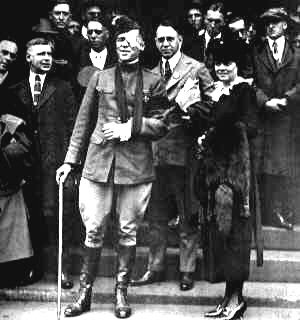The Dashing Floyd Gibbons
Floyd Gibbons was one of the twentieth century’s most swashbuckling reporters, complete with a trademark eye patch, worn because he lost an eye in while advancing with the Fifth Marines on the battlefield of Belleau Wood in June 1918.
Gibbons began his career as a reporter in Minneapolis, but he gained a national reputation as a reporter for the Chicago Tribune. During the fifteen years he worked for the Tribune, he made the news as well as reporting on it. Assigned to cover General John Pershing’s troops in the Mexican Punitive Expedition in 1916,* he instead chose to travel with Mexican leader Pancho Villa, filing exclusive stories from the other side of the conflict. He was on board the liner RMS Laconia en route to London as a war correspondent when a German submarine sank the ship in February 1917—and immediately filed a dramatic eyewitness report on the experience as soon as the rescued passengers reached shore in Ireland. He covered the arrival of American troops in France, the first American artillery shots fired in the war, and the first American offensive of the war at Cantigny. ** His heroics at Belleau Wood, where he lost his eye attempting to rescue a Marine officer, earned him the French Croix de Guerre and turned him into a celebrity back home: he was greeted in New York by a Marine honor guard and a crowd of shouting reporters.
As the war drew to an end, Robert McCormick and his cousin and partner Joseph Patterson, decided to build a European presence for the Chicago Tribune and Patterson’s New York Daily News. They already had a structure in place in the form of the “Army Edition,” the newspaper McCormick produced for soldiers during the war. In November, 1918, a week after the Armistice, McCormick gave Gibbons the job of creating two overlapping news organizations that built on the Army Edition framework: the Tribune’s Foreign News Service*** and the European Edition of the Chicago Tribune and the New York Daily News, known to both its staff and readers as the “Paris Edition.”
Gibbons not only ran the Tribune’s Foreign News Service, he worked as its chief “roaming correspondent,” following stories across Europe, Asia, and Africa. He was fired in 1927, after running up a $20,000 expense account bill on a safari to Timbuktu. (He told fellow Tribune reporter George Seldes that it was worth it: he had always wanted to send his mother a card postmarked Timbuktu.)
Back in the United States, Gibbons became active in the new forms of media that were developing. He was one of the first radio news commentators, becoming known for a fast-talking style of delivery that was the verbal equivalent of his prose. He narrated newsreels, for which he received a star on the Hollywood Walk of Fame, a documentary titled With Byrd at the South Pole and a series of short films called “Your True Adventures.”
Gibbons returned to foreign correspondence in the 1930s, reporting on Mussolini’s invasion of Ethiopia in 1935 and covering both sides of the Spanish Civil War in 1936.
His death on September 24, 1939, cut short his plans to return to Europe, where Germany had invaded Poland only weeks previously.
*A side show in the Mexican Revolution of 1910, and not a shining hour for the United States. It probably warrants a blog post in its own right one of these days since I’ve been stumbling across it regularly for several years now. Until then, here’s a link to an old post that involves Pancho Villa’s army and the Mexican Revolution of 1910: Petra Herrera Wanted to be a General.
**Gibbons’ boss, the owner and publisher of the Chicago Tribune, Robert McCormick was also at Cantigny, where he earned the rank of Lieutenant-Colonel.
***The organization for which Sigrid Schultz worked in Berlin.





